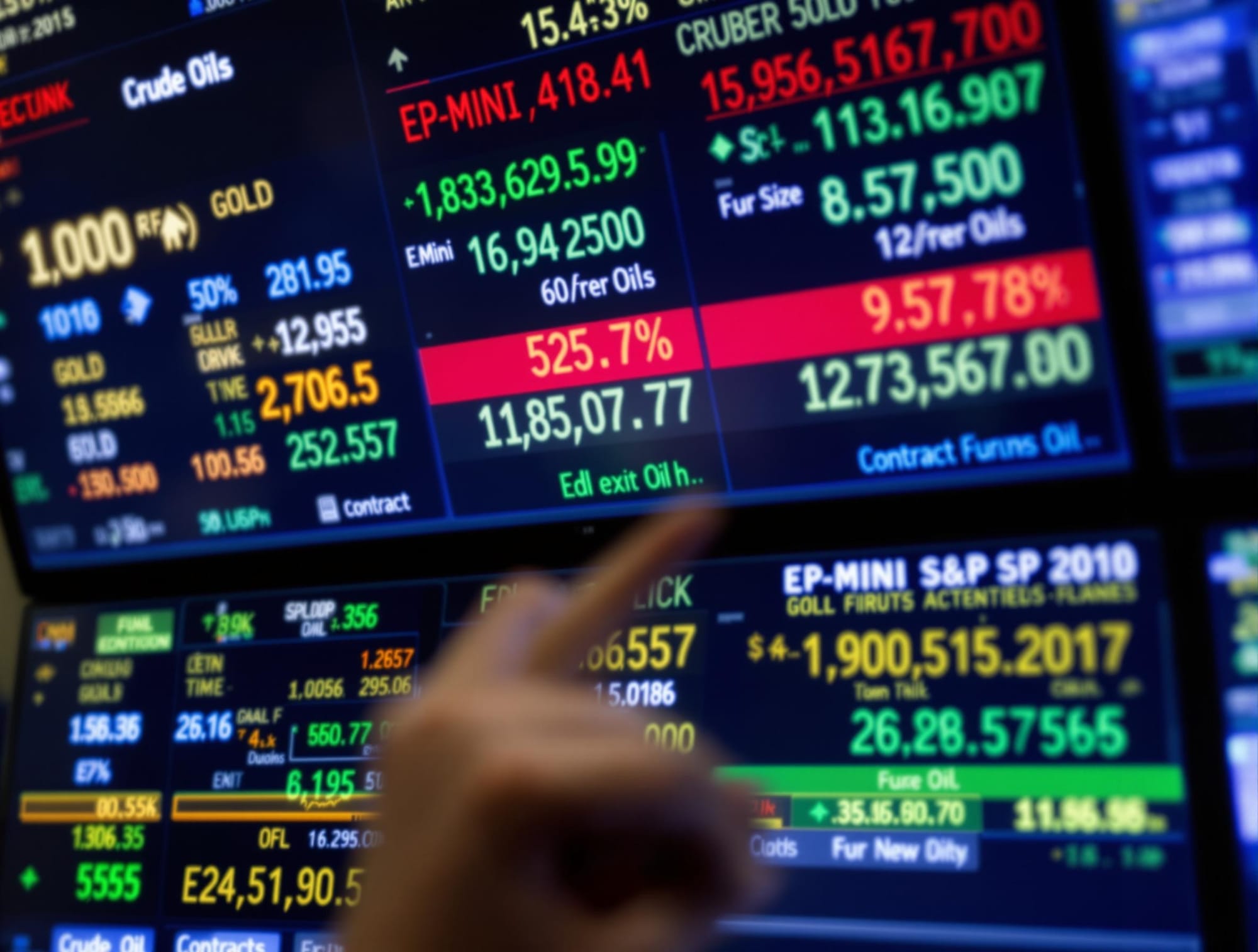What Are Futures Contract Symbols? How to Use Them

What Is a Futures Symbol?
A futures symbol is a unique code assigned to each futures contract traded on an exchange. These ticker symbols represent not just the underlying asset, but also the expiration month and year, making them essential for identifying and trading the correct contract. Whether you're tracking the E-mini S&P 500, gold, or crude oil, recognizing the right code ensures precision in trading.
Why Futures Symbols Matter in Day Trading
Futures contract symbols are crucial in day trading, where speed and accuracy matter most. Mistaking one symbol for another can lead to trading the wrong market, the wrong contract month, or even using the wrong futures trading strategies. For instance, trading the active contract instead of an expiring one can help manage liquidity, slippage, and risk. Do you double-check your futures symbols before every trade?
Where Futures Symbols Show Up on Trading Platforms
On trading platforms, you’ll see futures contract symbols almost everywhere: watchlists, order entry screens, charts, and even in trade confirmation emails. Futures symbology allows platforms to correctly route your trades to the desired contract among thousands available in the market. Are you familiar with where to enter or review the correct futures ticker symbols on your preferred trading platform? Many helpful platforms are outlined at Funded Futures Network Preferred Platforms.
How Futures Symbols Are Structured
Every futures symbol follows a systematic approach—a combination of letters and numbers that tells you the asset and its expiration specifics at a glance. Understanding this structure makes working with futures codes for YM, NQ future symbols, oil, gold, and micro contracts much easier.
Base Ticker + Expiration = Your Symbol
The foundation of all futures symbols starts with a base ticker that represents the underlying asset. This is followed by a letter (the expiration symbol) for the month and a number or pair of numbers for the contract year. For example, “ESM24” means the E-mini S&P 500 contract (ES), for June (M), in the year 2024 (24).
Learning the format of “[Base Ticker][Month Code][Year]” helps demystify all sorts of combinations, whether you’re checking micro futures symbols, oil futures symbols, or any other futures contract codes.
What the Expiration Symbol Actually Means
The expiration symbol, or futures month code, is set by exchange standards and tells you which month a contract will settle. Each month has an assigned letter: for example, “F” for January, “G” for February, “H” for March, and so on. These symbols are vital for rolling positions and picking contracts with the best liquidity.
Misreading the expiration symbol could mean holding a soon-to-expire (and possibly illiquid) contract, which can have unexpected consequences for your trades and strategies. Are you keeping a list of the standard month codes handy when planning rollovers?
Futures Contract Month Codes Explained
Here is a quick guide to the standardized futures contract month codes:
- F = January
- G = February
- H = March
- J = April
- K = May
- M = June
- N = July
- Q = August
- U = September
- V = October
- X = November
- Z = December
Memorizing these month codes, or at least having them accessible, helps you avoid costly slip-ups and ensures you always select the right futures contract month.
What Do Futures Contract Symbols Look Like?
Let’s put the theory into practice by looking at real-world examples and understanding how futures symbology translates on common trading platforms.
Decoding a Sample Symbol: ESM24
Take ESM24 as an example:
- “ES”: Base ticker for E-mini S&P 500 futures
- “M”: Expiration symbol for June
- “24”: Contract year (2024)
Putting it together, ESM24 refers to the E-mini S&P 500 futures contract expiring in June 2024. Other assets, like the gold futures symbol or oil futures symbol, follow the same logic. Would you be able to decode a ticker like “CLZ23” (oil futures for December 2023) on your own?
Futures Symbology on Common Trading Platforms
Major trading platforms such as Thinkorswim, NinjaTrader, and Interactive Brokers display futures ticker symbols prominently in chart windows, watchlists, and order entry modules. Each platform follows the same standard for base ticker + month code + year—though some may include additional exchange suffixes.
Platforms may also offer drop-down menus to help pick the right futures contract codes quickly. Are you comfortable navigating symbology tools and ensuring you’re trading the active contract? Some providers even highlight the most liquid (or “front-month”) contracts automatically.
Difference Between Ticker Symbols and Futures Contract Codes
Regular stock ticker symbols identify only the security, like “AAPL” for Apple. Futures contract codes, by contrast, contain information about both the asset and its expiration—in one concise string. For example, the gold futures symbol “GCJ23” instantly tells you it’s a gold contract for April 2023, while a stock ticker alone wouldn’t have this extra layer of time specificity.
Understanding this extra dimension is vital for accurate futures trading, whether you’re rolling positions, evaluating carry costs, or just making sure you’re trading the intended contract.

How To Use Futures Symbols In Real Trading
Being able to read futures contract symbols empowers you to trade with confidence. But what does this look like in day-to-day trading? Let’s dig into picking contract months, rolling over, and using the right symbols for analysis.
How to Pick the Right Contract Month
Liquidity matters in futures trading. The most liquid contracts, called “front month” contracts, usually attract the bulk of trading volume and have the tightest bid/ask spreads. Check daily volume or open interest to spot the correct front-month contract, using its corresponding futures symbol.
If your strategy is short-term, you’ll nearly always trade the front month. Longer-term traders or hedgers might use deferred months to time their exposures or manage roll costs. Are you confirming liquidity and roll dates for your chosen contract symbols before you commit capital?
When to Roll Over a Futures Contract
Each futures contract expires on a set schedule, and traders typically “roll” their positions to the next contract before that date. This involves selling the expiring contract and buying the next month’s contract, using the new symbol. Rollover calendars—such as those provided by brokers, or at Funded Futures Network’s rules page—help you avoid holding contracts into expiration, especially in physically-delivered markets like oil.
Missing a rollover can expose you to settlement risk or, in the case of certain commodities, unintended physical delivery!
Using Futures Ticker Symbols For Analysis
When running technical or fundamental analysis, using the correct futures ticker symbols ensures you’re reviewing data for the right contract. Many platforms allow analysis on a specific contract (e.g., ESU24) or a continuous chart that “stitches” together active contracts, smoothing historical trends.
For backtesting trading strategies, always note if you’re using true contract data or a continuous data series. Do your studies and trade logs reflect the correct base symbols and expiration periods?
Specific Product Examples For Popular Markets
Understanding futures symbology is easier with examples from major market contracts. Here’s how you’ll spot and use gold, oil, and index futures contract symbols, including micros and comparative codes.
Gold Futures Symbol
Gold futures trade under the base ticker “GC.” For example, “GCJ24” refers to the gold contract for April 2024, and “GCZ23” would be the December 2023 contract. These gold futures symbols are seen on exchanges like COMEX and popular platforms.
Oil Futures Symbol
Oil futures (specifically WTI crude oil) use the “CL” base ticker. For example, “CLM24” is the June 2024 oil futures symbol, while “CLQ23” would be the August 2023 contract. Make sure to differentiate between types; Brent crude uses “BZ” as its base.
Micro Futures Symbols
For smaller traders, micro futures symbols make market access easier. For example, the micro E-mini S&P 500 uses “MES” (e.g., “MESU24”), and the micro gold contract uses “MGC” (e.g., “MGCZ23”). Micro contracts offer the same exposure at a fraction of the standard contract size and appear on most popular trading platforms.
NQ Future Symbols vs YM Futures Codes
The NQ future symbol represents the E-mini NASDAQ-100 future, while YM is the Dow Jones Industrial Average. NQ symbols look like “NQM24” for June 2024, and YM codes look like “YMU24.” Understanding their symbols allows you to compare or trade these index futures seamlessly.
How to Read Futures Codes for YM, NQ, and ES
To read futures contract symbols—such as those for the Dow Jones (YM), Nasdaq-100 (NQ), and S&P 500 (ES)—just break down each part of the code. The first part is always the base ticker: "YM" for Dow, "NQ" for Nasdaq futures, and "ES" for the E-mini S&P 500. The next part is the single-letter expiration symbol, which indicates the contract month using the industry-standard futures contract month codes (for example, "H" is March, "M" is June, "U" is September, and "Z" is December). The final part of the code is a one- or two-digit year, such as "24" for 2024.
So, “ESM24” means the E-mini S&P 500 contract for June 2024; “NQU24” means the E-mini Nasdaq-100 for September 2024; and “YMH25” would indicate the Dow contract for March 2025. Being able to instantly decode these futures symbols helps you avoid trading the wrong contract and streamlines your research and order entry. Many platforms support easy lookup and confirmation, but always double check your work—missing or misreading just one letter or number can take your trading in the wrong direction.
Common Mistakes With Futures Symbols
Mistakes with futures contract symbols can lead to costly errors and unwanted positions. Understanding these pitfalls will help you trade more confidently and avoid unnecessary risk.
Trading the Wrong Month
One of the most common errors occurs when a trader accidentally inputs or selects the wrong expiration month. If you don't pay attention to the expiration symbol, you might open a position in a contract that’s about to expire—potentially facing low liquidity or even getting caught in physical delivery if you do not roll or close in time. This is especially risky during rollover periods when multiple contract months have similar trading volume. Checking expiration dates and volume is a must before placing orders.
Confusing Continuous Charts With Active Contracts
Many traders rely on continuous charts to analyze a product's historical price action. These charts "stitch" together contract data from the most active futures month, but they don’t represent any one specific live contract. If you try to trade based on a symbol from a continuous chart, you might pick an expired or illiquid month. Always confirm you are viewing the real, tradable contract symbol for order entry.
Misreading Expiration Symbols or Misusing Futures Symbols
Futures symbology is designed to be quick and clear, but mistakes still happen. Misreading letters (like mixing up “M” for June and “N” for July) or mistyping digits in the year can put you in the wrong contract. Similarly, applying a stock ticker approach to futures—omitting expiration symbols or year—leads to errors and confusion. Always double check your entry, especially when switching between markets or setting up trading automation.

FAQs about Futures Symbols
What is the format of a futures contract symbol?
A futures contract symbol follows the format: Base Ticker + Month Code + Year. For example, “CLM24” stands for crude oil ("CL"), June ("M"), 2024 ("24"). This format helps traders quickly pinpoint the exact product and contract they’re trading. The month code is always a single letter, based on standards used across exchanges.
How can I find the correct contract month?
Choose the contract month with the highest trading volume and open interest—this is usually called the “front month.” You’ll often see it featured at the top of trading platforms and market data services. For roll dates and more, check your broker’s contract specifications or visit Funded Futures Network’s rules for more guidance.
What’s the difference between base tickers and futures contract codes?
The base ticker represents only the underlying product, such as “NQ” for Nasdaq futures or “GC” for gold. The full contract code—like “NQU24” or “GCZ23”—adds the expiration symbol and year, making it possible to identify the specific contract to trade. Base tickers are helpful for searching or comparing all available contracts for a product.
Can I trade using micro futures symbols on all platforms?
Micro futures symbols, like “MES” for micro E-mini S&P 500 or “MNQ” for micro Nasdaq, are available on most modern trading platforms that support futures. However, some platforms might require specific account types or not offer every micro contract. Check your broker's available products in their symbol lookup or preferred platforms list.
What’s the gold futures symbol for current contracts?
The gold futures symbol is "GC," followed by the code for the current active month and year. For example, if June 2024 is the current front month, the symbol is "GCM24." Always verify the current front month via platform watchlists or CME Gold Futures product page.
Are futures ticker symbols different on every exchange?
Most exchanges use standardized ticker formats, but there can be small differences—especially for international contracts or unique exchange conventions. Always consult your trading platform’s symbol lookup or check the exchange’s website directly for the most accurate codes.



